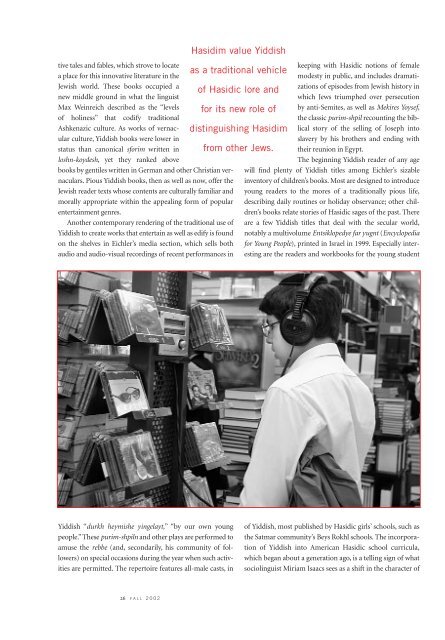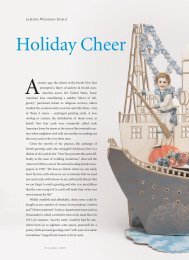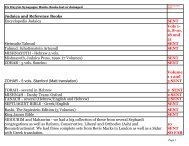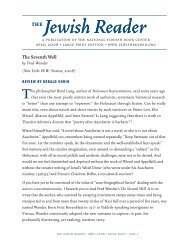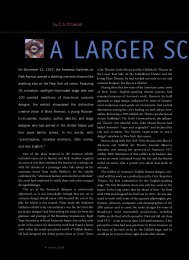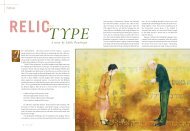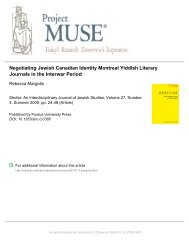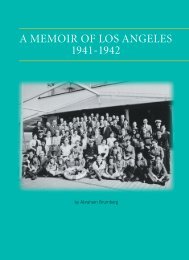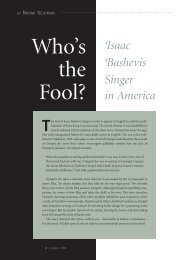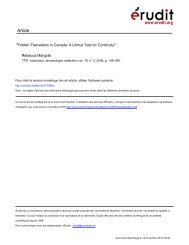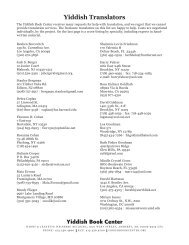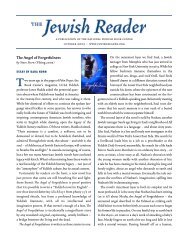tive tales and fables, which strove to locatea place <strong>for</strong> this innovative literature in theJewish world. These books occupied anew middle ground in what the linguistMax Weinreich described as the “levelsof holiness” that codify traditionalAshkenazic culture. As works of vernacularculture, <strong>Yiddish</strong> books were lower instatus than canonical s<strong>for</strong>im written inloshn-koydesh, yet they ranked abovebooks by gentiles written in German and other Christian vernaculars.Pious <strong>Yiddish</strong> books, then as well as now, offer theJewish reader texts whose contents are culturally familiar andmorally appropriate within the appealing <strong>for</strong>m of popularentertainment genres.Another contemporary rendering of the traditional use of<strong>Yiddish</strong> to create works that entertain as well as edify is foundon the shelves in Eichler’s media section, which sells bothaudio and audio-visual recordings of recent per<strong>for</strong>mances inHasidim value <strong>Yiddish</strong>as a traditional vehicleof Hasidic lore and<strong>for</strong> its new role ofdistinguishing Hasidimfrom other Jews.keeping with Hasidic notions of femalemodesty in public, and includes dramatizationsof episodes from Jewish history inwhich Jews triumphed over persecutionby anti-Semites, as well as Mekires Yoysef,the classic purim-shpil recounting the biblicalstory of the selling of Joseph intoslavery by his brothers and ending withtheir reunion in Egypt.The beginning <strong>Yiddish</strong> reader of any agewill find plenty of <strong>Yiddish</strong> titles among Eichler’s sizableinventory of children’s books. Most are designed to introduceyoung readers to the mores of a traditionally pious life,describing daily routines or holiday observance; other children’sbooks relate stories of Hasidic sages of the past. Thereare a few <strong>Yiddish</strong> titles that deal with the secular world,notably a multivolume Entsiklopedye far yugnt (Encyclopedia<strong>for</strong> Young People), printed in Israel in 1999. Especially interestingare the readers and workbooks <strong>for</strong> the young student<strong>Yiddish</strong> “durkh heymishe yingelayt,” “by our own youngpeople.” These purim-shpiln and other plays are per<strong>for</strong>med toamuse the rebbe (and, secondarily, his community of followers)on special occasions during the year when such activitiesare permitted. The repertoire features all-male casts, inof <strong>Yiddish</strong>, most published by Hasidic girls’ schools, such asthe Satmar community’s Beys Rokhl schools. The incorporationof <strong>Yiddish</strong> into American Hasidic school curricula,which began about a generation ago, is a telling sign of whatsociolinguist Miriam Isaacs sees as a shift in the character of26 FALL 2002
<strong>Yiddish</strong> among postwar Hasidim from an “immigrantlanguage” to a “minority language.” Today, <strong>Yiddish</strong> primers,activity books, and even stickers (teachers can rewardstudents with a colorful “Zeyer gut!” or “Gevaldig!” or“Geshmak!”) both teach the language to haredi children andimbue it with meaning as a signifier of piety in daily life.Eichler’s also sells a variety of games and puzzles thatincorporate <strong>Yiddish</strong> into children’s play activities. Among themore elaborate games is Handl erlikh (“Deal honestly”),a knock-off of Monopoly that replaces the streets of AtlanticCity with place names of importance to the Hasidic world,past (Cracow and Lublin) and present (London, Montreal,and, of course, Boro Park). As players work their way aroundthe board, buying and renting properties, they are taughtlessons in piety as well as proper social and business conduct.The game’s instruction booklet explains in <strong>Yiddish</strong> thatHandl erlikh will “implant in children good character andreverence <strong>for</strong> God. Whoever deals honestly will have muchsuccess.” Players must tithe all their income, and khezhbnhanefesh(personal reckoning) cards penalize players <strong>for</strong> disobeyingone’s parents, <strong>for</strong>getting to recite a brokhe, watchingtelevision – or <strong>for</strong> speaking either English or modern Hebrew.The Meaning of <strong>Yiddish</strong> in Boro ParkThis implicit endorsement of <strong>Yiddish</strong> as the Hasidic vernacularof choice should not be mistaken <strong>for</strong> <strong>Yiddish</strong>ism,which the haredi community typically regards with greatsuspicion. In fact, a recent letter to the editor in Mayles, amonthly <strong>Yiddish</strong> magazine <strong>for</strong> Hasidic families publishedin Monsey, New York, criticizes the journal <strong>for</strong> what thereader considers a tendency toward <strong>Yiddish</strong>ism, evinced byits ef<strong>for</strong>ts to explain <strong>Yiddish</strong> grammar and provide glossariesof <strong>Yiddish</strong> terminology. (“Who says that there has tobe a <strong>Yiddish</strong> word <strong>for</strong> everything?” asks the letter’s author.“Not all languages are equally rich.”) Indeed, Hasidim whospeak <strong>Yiddish</strong> do not celebrate the language as the fountainheadof a wide-ranging, thousand-year-old Ashkenazicheritage that embraces labor movements and avant-gardepoetry as well as Hasidism, and they are suspicious ofef<strong>for</strong>ts to cultivate <strong>Yiddish</strong> <strong>for</strong> its own sake. Instead, theyvalue <strong>Yiddish</strong> both as a traditional vehicle of Hasidic loreand <strong>for</strong> its new role – one that has emerged in the post-Holocaust era – of distinguishing Hasidim from other Jews.Not surprising, then, that the non-Hasid who goes to BoroPark hoping to try out his or her <strong>Yiddish</strong> on the locals mayfind such ef<strong>for</strong>ts frustrated. Some Hasidim will refuse torespond to an outsider’s <strong>Yiddish</strong> in the language but willanswer in English instead. Literary scholar Richard Fein wroteof his largely unsuccessful ef<strong>for</strong>ts to engage LubavitcherHasidim in <strong>Yiddish</strong>, when he visited the community in CrownHeights, another Brooklyn neighborhood, in the late 1970s:Only later did I realize that the members of the familydid not speak to me in <strong>Yiddish</strong> because Hasidim don’twant to advance the presence of a secular Jew whospeaks <strong>Yiddish</strong>....<strong>Yiddish</strong>, <strong>for</strong> the Hasidic family, is thedaily part and parcel of a religious way of life. It is not alanguage that one cultivates <strong>for</strong> personal or intellectualor cultural reasons, as they correctly saw me doing.<strong>Yiddish</strong> was certainly not simply a language like anyother that one might help someone else to learn. While<strong>Yiddish</strong> was basic to me, they saw it as merely incidentalin my life, merely “an interest.” <strong>Yiddish</strong> was basic tothem, but in a completely different way.Like Fein, many devotees of <strong>Yiddish</strong> have come to it as a“discovery” (or, in Fein’s case, a rediscovery of a language hehad heard and even briefly studied as a child, as he explains inhis memoir, The Dance of Leah). They encounter <strong>Yiddish</strong> inclassrooms, festivals, and other venues where lovers of the languageconvene – places removed from their daily routines, inwhich they generally use other languages. For Fein and manyother <strong>Yiddish</strong>ists, the appeal of seeing <strong>Yiddish</strong> in situ, materializedin an environment in which the language is indigenous– the desire to pay a visit to <strong>Yiddish</strong>land – cannot be underestimated.Boro Park isn’t <strong>Yiddish</strong>land; indeed, some <strong>Yiddish</strong>istsdeplore the state of <strong>Yiddish</strong> among contemporary Hasidim,complaining that it isn’t regarded as a full or “pure” languageand that Hasidim regularly flout linguistic standards, or eventhe idea of standards. Nevertheless, the neighborhood offersan encounter with <strong>Yiddish</strong> that other settings cannot provide.Whatever their religious convictions, <strong>Yiddish</strong> enthusiastsshould not shrink from visiting Boro Park or other Hasidicneighborhoods in New York and elsewhere, but they shouldbear in mind that their attraction to places where <strong>Yiddish</strong>thrives in the marketplace does not con<strong>for</strong>m to the communities’own commitments, including their commitment to<strong>Yiddish</strong>. Such encounters can not only pose challenges; theycan enrich one’s awareness of cultural creativity among Jewstoday, and expand one’s concept of the possibilities of <strong>Yiddish</strong>in its second millennium. PTJeffrey Shandler is an assistant professor in the Department ofJewish Studies at Rutgers University. He is the author ofWhile America Watches: Televising the Holocaust (Ox<strong>for</strong>dUniversity Press, 1999) and the editor of Awakening Lives:Autobiographies of Jewish Youth in Poland be<strong>for</strong>e theHolocaust (Yale University Press, 2002). He is currentlyworking on a study of <strong>Yiddish</strong> culture after World War II.27 PAKN TREGER


